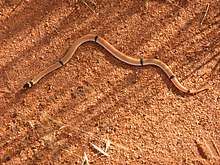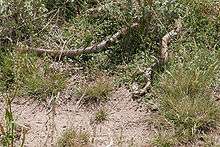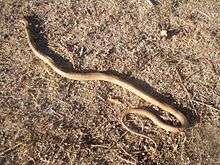Pseudonaja
| Pseudonaja | |
|---|---|
 | |
| Ringed brown snake (P. modesta) in Northern Territory, Australia | |
| Scientific classification | |
| Kingdom: | Animalia |
| Phylum: | Chordata |
| Class: | Reptilia |
| Order: | Squamata |
| Suborder: | Serpentes |
| Family: | Elapidae |
| Subfamily: | Hydrophiinae |
| Genus: | Pseudonaja Günther, 1858 |
Pseudonaja is a genus of venomous elapid snakes native to Australia. Species of this genus are known commonly as brown snakes and are considered to be some of the most dangerous snakes in the world; even young snakes are capable of delivering a fatal envenomation to a human.
Despite its common name, the king brown snake (Pseudechis australis) is not a brown snake, but a member of the genus Pseudechis, commonly known as black snakes.
Species
The following species and subspecies are recognized.[1]
- Pseudonaja affinis Günther, 1872 — dugite or spotted brown snake
- Pseudonaja affinis affinis Günther, 1872 — coastal mainland Western Australia.
- Pseudonaja affinis exilis Storr, 1989 — mainland Western Australia and Rottnest Island.
- Pseudonaja affinis tanneri (Worrell, 1961) — mainland Western Australia, Boxer Island and other islands.
- Pseudonaja aspidorhyncha (F. McCoy, 1879)[2] strap-snouted brown snake — inland eastern Australia
- Pseudonaja guttata (Parker, 1926) — speckled brown snake or spotted brown snake — Northern Territory, Queensland, and South Australia.
- Pseudonaja inframacula (Waite, 1925) — peninsula brown snake — South Australia, Western Australia, Eyre Peninsula.
- Pseudonaja ingrami (Boulenger, 1908) — Ingram's[3] brown snake — Northern Territory, Queensland, and Western Australia.
- Pseudonaja mengdeni Wells & Wellington, 1985[2] — gwardar or western brown snake — New South Wales, Northern Territory, Queensland, South Australia, Victoria, and Western Australia
- Pseudonaja modesta (Günther, 1872) — ringed brown snake — New South Wales, Northern Territory, Queensland, South Australia, and Western Australia.
- Pseudonaja nuchalis Günther, 1858 — northern brown snake — Northern Territory, Queensland.
- Pseudonaja textilis (A.M.C. Duméril, Bibron & A.H.A. Duméril, 1854) — eastern brown snake — New South Wales, Northern Territory, Queensland, South Australia, Victoria, Western Australia, south-eastern West Papua, and both south-eastern (Central Province) and north-eastern (Oro & Milne Bay Provinces) Papua New Guinea.

N.B: A binomial authority in parentheses indicates that the species was originally described in a genus other than Pseudonaja. Similarly, a trinomial authority in parentheses indicates that the subspecies was originally described in a genus other than Pseudonaja.
Toxicity
Brown snakes accounted for 41% of identified snakebite victims in Australia between 2005 and 2015, with 15 deaths recorded from 296 confirmed envenomations—far more than any other type of snake.[4]
Brown snakes are easily alarmed and may bite if approached closely, handled, or threatened. Sudden, early collapse is often a feature of brown snake envenomation. A prominent effect of envenomation is venom-induced consumption coagulopathy and this can lead to death. Renal damage may also rarely occur.[5]
Other clinical signs include: abdominal pain, breathing and swallowing difficulty, convulsions, ptosis, hemolysis, hypotension from depression of myocardial contractility, and renal failure. Notably rhabdomyolysis is not a feature of envenomation by brown snakes.
The eastern brown snake (Pseudonaja textilis) is the most toxic member of the genus and is considered by some to be the second most toxic land snake in the world, after the inland taipan (which is also found in Australia). The western brown snake is the tenth most venomous snake in the world.
Brown snakes can easily harm animals and livestock as well.
The venom fangs of snakes of the genus Pseudonaja are very short, and the average yield of venom per bite is relatively low — for P. textilis, P. nuchalis, and P. affinis, about 4 to 6.5 mg dry weight of venom.[6] Therefore, most of the bites end up without serious medical consequences. Despite its toxicity the smallest Pseudonaja, P. modesta, can even be considered harmless.[6] Bites by the bigger species of Pseudonaja, especially P. textilis and P. nuchalis, are known for causing serious toxicosis and fatalities.
References
- ↑ "Pseudonaja ". The Reptile Database. www.reptile-database.org.
- 1 2 Skinner, Adam (2009). "A multivariate morphometric analysis and systematic review of Pseudonaja (Serpentes, Elapidae, Hydrophiinae)". Zoological Journal of the Linnean Society. 155: 171–97. doi:10.1111/j.1096-3642.2008.00436.x.
- ↑ Beolens, Bo; Watkins, Michael; Grayson, Michael (2011). The Eponym Dictionary of Reptiles. Baltimore: Johns Hopkins University Press. xiii + 296 pp. ISBN 978-1-4214-0135-5. (Pseudonaja ingrami, p. 130).
- ↑ Johnston, Christopher I.; Ryan, Nicole M.; Page, Colin B.; Buckley, Nicholas A.; Brown, Simon G.A.; O'Leary, Margaret A.; Isbister, Geoffrey K. (2017). "The Australian Snakebite Project, 2005–2015 (ASP-20)" (PDF). Medical Journal of Australia. 207 (3): 119–25. doi:10.5694/mja17.00094.
- ↑ Isbister, Geoff; et al. (2006). "Snake Bite: Current Approach to Treatment". Australian Prescriber. 29 (5): 125–129.
- 1 2 Mirtschin PJ, Crowe GR, Davis R (1990). "Dangerous Snakes Of Australia". In: Gopalakrishnakone P, Chou LM (1990). Snakes of Medical Importance. Venom and Toxin Research Group, National University of Singapore. pp. 49–77, especially p. 49.
Further reading
- Günther A (1858). Catalogue of the Colubrine Snakes in the Collection of the British Museum. London: Trustees of the British Museum. (Taylor and Francis, printers). xvi + 281 pp. (Pseudonaja, new genus, p. 227).
External links
| Wikimedia Commons has media related to Pseudonaja. |
- Genus Pseudonaja at The Reptile Database
